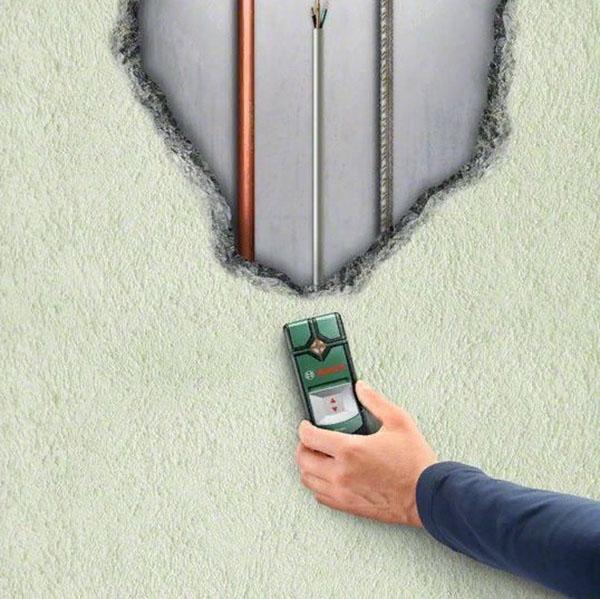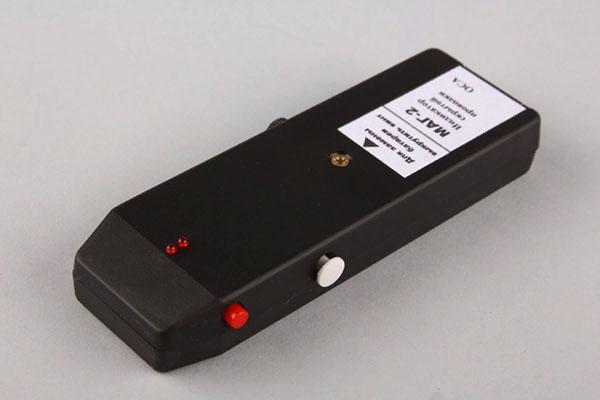What is a hidden wiring alarm for?
 During renovations, redevelopments, you almost always have to make holes in the wall. In order not to accidentally get into the wiring, which is hidden in it, they use a special device - a hidden wiring signaling device. This device weighs only ~ 250 grams, but it can provide tangible assistance in repair work. After all, there is little pleasant in getting a drill into a pipe or an electric cable.
During renovations, redevelopments, you almost always have to make holes in the wall. In order not to accidentally get into the wiring, which is hidden in it, they use a special device - a hidden wiring signaling device. This device weighs only ~ 250 grams, but it can provide tangible assistance in repair work. After all, there is little pleasant in getting a drill into a pipe or an electric cable.
Varieties of the device

Most of the devices are small metal detectors. The downside is that the hidden wiring detector will react to any metal object. Therefore, if there is, for example, fittings in the wall, it will constantly signal this.
To detect electrical wiring, there are special devices that catch the electromagnetic field that forms when current flows through the wires.
If there is moisture on the wall (from dampness), then the readings of the device will be false, because water tends to reflect the electromagnetic field.
The most optimal option is a universal device for finding hidden wiring. The advantage is that by switching modes, you can find in the wall as metal pipesand electrical wiring. There are more expensive models with which you can recognize plastic, wood. But there must be moisture on them. Such hidden wiring alarms are much more expensive than their simplified counterparts, and therefore are considered professional.
Indicator screwdriver
 A screwdriver-shaped hidden wire breakage detector measures voltage. Thus, where the current is detected, there is the wiring. The device itself is transparent. When voltage is detected, a light and sound signal will be emitted from within. The tip of the screwdriver is straight for easy attachment to the wall.
A screwdriver-shaped hidden wire breakage detector measures voltage. Thus, where the current is detected, there is the wiring. The device itself is transparent. When voltage is detected, a light and sound signal will be emitted from within. The tip of the screwdriver is straight for easy attachment to the wall.
The wiring detector in the form of a screwdriver is affordable. There are both contact and non-contact models. There are also additional modifications designed for different voltages and conditions.
With the help of such devices, you can easily find out if the outlet is working, determine the voltage.
Contact model
 Contact models are capable of:
Contact models are capable of:
- determine the functioning of the outlet;
- check if the extension cord is grounded;
- find the phase of the cartridge in the chandelier, phase wires during the installation of electrical appliances.
To start the signaling device of hidden wiring, you need to press just one button "on" (on the handle-holder). It is a sting to touch the contact. If voltage is present, the lamp will light up. This is how the phase wire is found. Bodily contact is necessary because a person is part of an electrical circuit. The current will not harm, it is too weak due to the built-in resistor that creates a strong resistance.
The contact model is the simplest hidden wiring detector. If you don't need extra features, then consider purchasing this option.
Poor build is very common, so read reviews about a particular model before purchasing and buy only from trusted stores.
Non-contact model
 The proximity indicator for hidden wiring is battery operated. The device is equipped with a LED that consumes minimum energy. The detection zone for contactless models is not large, but the indicator is able to detect wiring even under a small layer of plaster and cement.
The proximity indicator for hidden wiring is battery operated. The device is equipped with a LED that consumes minimum energy. The detection zone for contactless models is not large, but the indicator is able to detect wiring even under a small layer of plaster and cement.
The work is based on the creation of its own magnetic field.
Advantage: They can be replaced with a screwdriver by unscrewing a few screws and bolts (be careful not to damage). Disadvantage: The battery requires periodic replacement.
Contactless models can be electronic. They not only determine the voltage, but also display its value on the display. The minimum is 15 V, the maximum is 250 V. Of course, such devices are convenient, but their cost is much higher.
How to choose a hidden wiring alarm
 Now it's worth figuring out which wiring detector to choose. First you need to decide for what purpose the device is being purchased. Its functionality will depend on this. For example, to detect only electrical wiring, it is enough to buy a conventional detector. But if you need such functions as defining frames, piping, wall wiring indicator, you need to choose more carefully.
Now it's worth figuring out which wiring detector to choose. First you need to decide for what purpose the device is being purchased. Its functionality will depend on this. For example, to detect only electrical wiring, it is enough to buy a conventional detector. But if you need such functions as defining frames, piping, wall wiring indicator, you need to choose more carefully.
By scanning depth
 Cheap models are able to scan no further than 2 cm. Often this is not enough, because the layer of the same plaster is about 3-4 cm. Of course, the longer the scanning range, the better. But at the same time, the price rises, so choose the best option, depending on your needs.
Cheap models are able to scan no further than 2 cm. Often this is not enough, because the layer of the same plaster is about 3-4 cm. Of course, the longer the scanning range, the better. But at the same time, the price rises, so choose the best option, depending on your needs.
You need to focus not only on the distance at which the indicator acts to detect hidden wiring, but also with what material it works.
This information is usually indicated on the packaging or in the specification sheet.
By type of indication
 Devices can signal the presence of wiring in different ways. There are 3 options:
Devices can signal the presence of wiring in different ways. There are 3 options:
- Sound notification. If the indicator is designed to search for different materials, the sound will be different in tone or duration.
- Light signal. LED bulbs that light up when identifying wiring or communications. Just like sound, notification changes depending on the material (color, glow intensity). If you know the response of the device to certain materials, you can quickly learn to identify them with high accuracy.
- Liquid crystal display. Indicators with a screen are the most expensive, but also the most ergonomic. The display of information is accurate and understandable, nothing needs to be deciphered. Sometimes sound and screen alarms are combined in one device, which makes the use even more convenient.
Regardless of which device you choose with which notification, you will need to get used to it - to study what signals and in what cases are given.
Before starting your search, practice in an open space - just move the detector to different materials - wood, metal, plastic.
But only if, for some reason, you have lost the packaging. It usually contains all the information you need to use.
Detection of wiring without alarm
 There are times when repairs are in full swing. Then the question of how to find the wiring in the wall without a device is very acute. There are several ways to do this. The most primitive is to remove the wallpaper, plaster, all layers, down to the brick base. But not many are ready for such capital work.
There are times when repairs are in full swing. Then the question of how to find the wiring in the wall without a device is very acute. There are several ways to do this. The most primitive is to remove the wallpaper, plaster, all layers, down to the brick base. But not many are ready for such capital work.
The second way is with the help of a radio receiver. You just need to tune it to a frequency of 100 kHz and attach it to the wall as close as possible. If there is a wiring in this place, the radio will make a specific sound.
The latter method is suitable for people who are addicted to technology. This is a multimeter search for wiring in the wall. In addition to a multimeter, you will need a field-effect transistor. On the multimeter, set the value to 200,000 ohms, and connect its probes to the left and middle outputs of the transistor.The right one plays the role of an antenna. A change in resistance on the display is a signal of the presence of the desired material behind the wall.